The church suffered a fire in 1921.
This blaze occurred on May 20th, 1921 in the rear of the East Liverpool Motors Company. The two story frame building was located on W. Fifth St. near Peach Alley. The fire spread to the First Methodist Protestant Church on the west side of the car company. Then, the two story brick building of Mrs. A. Martin on the east side became involved. Both the Ford motor car company and the church were destroyed. The Martin building suffered heavy damage. . . The church building was the oldest one in the city still being used as a church.
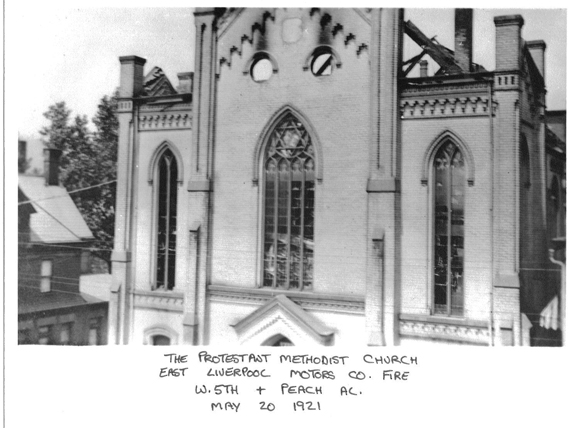
Picture from East Liverpool Fire Department Photo archives
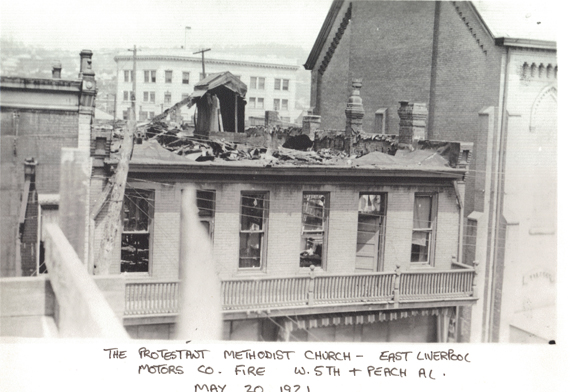
Picture from East Liverpool Fire Department Photo archives. The building to the right is the rear of the First United Presbyterian Church.
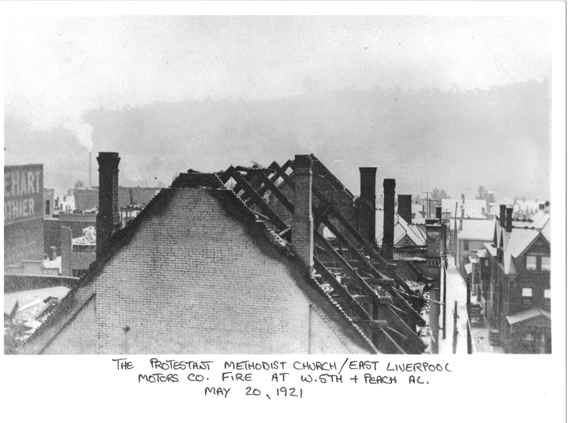
Picture from East Liverpool Fire Department Photo archives
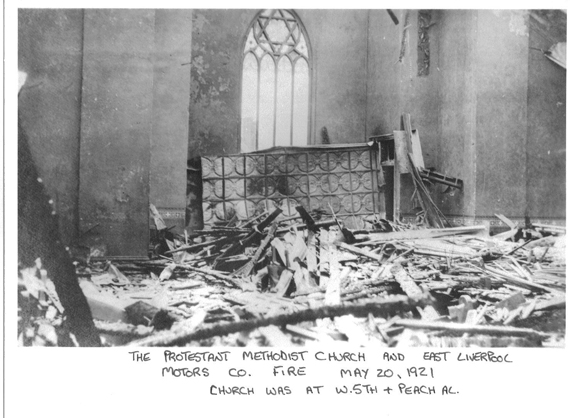
Picture from East Liverpool Fire Department Photo archives

Picture from East Liverpool Fire Department Photo archives
In picture directly above: Building in the center is the two story frame building of the East Liverpool Motor Co.
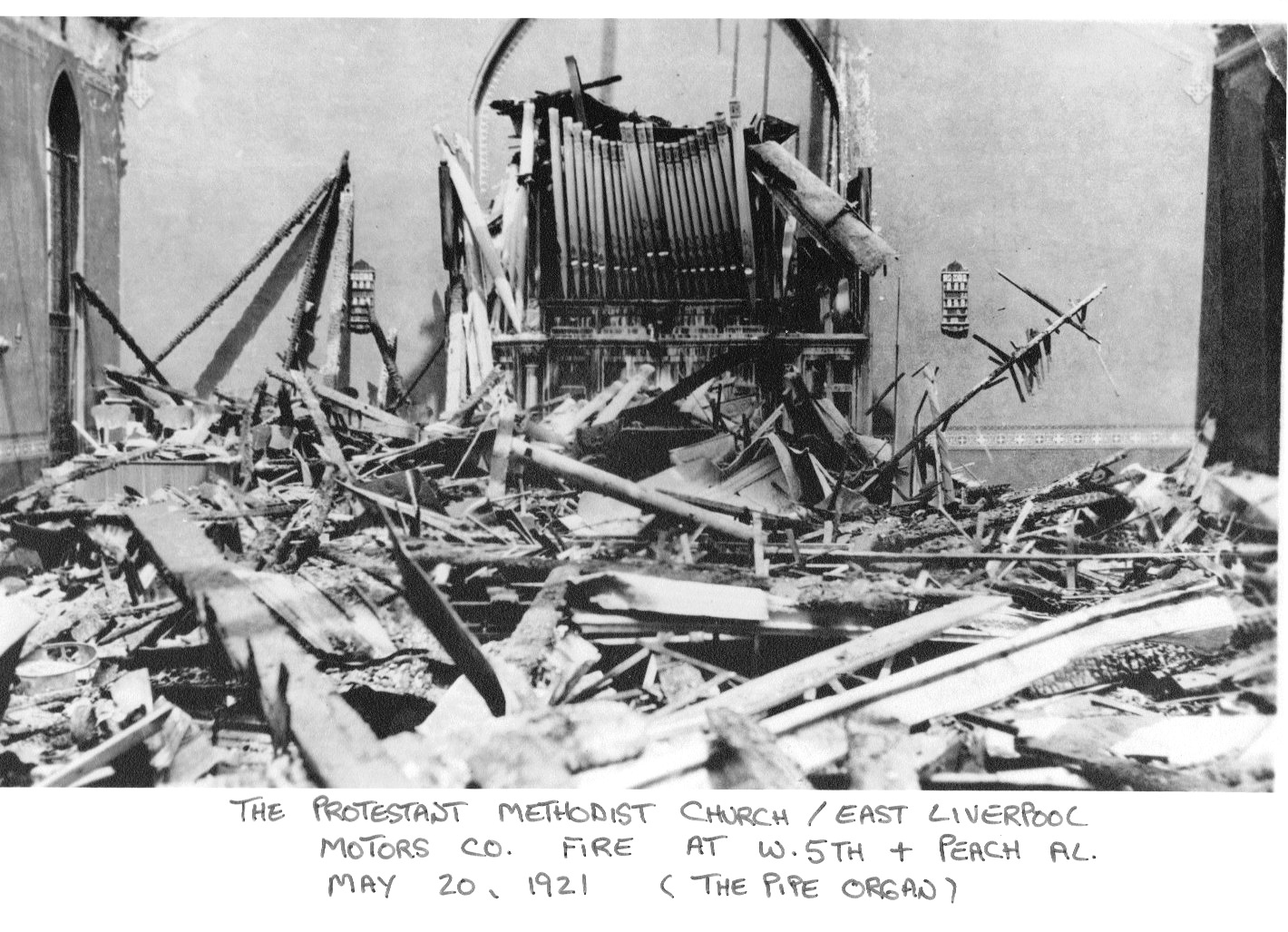
Picture from East Liverpool Fire Department Photo archives
Based on the pictures above it probably is safe to say that the interior of the Methodist Protestant Church bore some resemblance to the interior of the Methodist Episcopal Tabernacle. Probably not identical but a resemblance nonetheless.
The congregation built a new church which is located on the west side of Jackson Street between W 5th and W 6th Streets.
FIRST PRESBYTERIAN CHURCH
We will begin this with a repeat of the first two photographs from Part 1 to refresh memories.
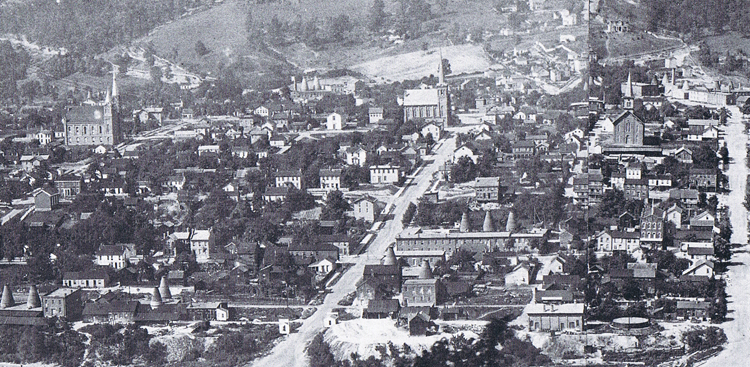
In this 1876 photograph the church on the far right is the First Presbyterian Church.
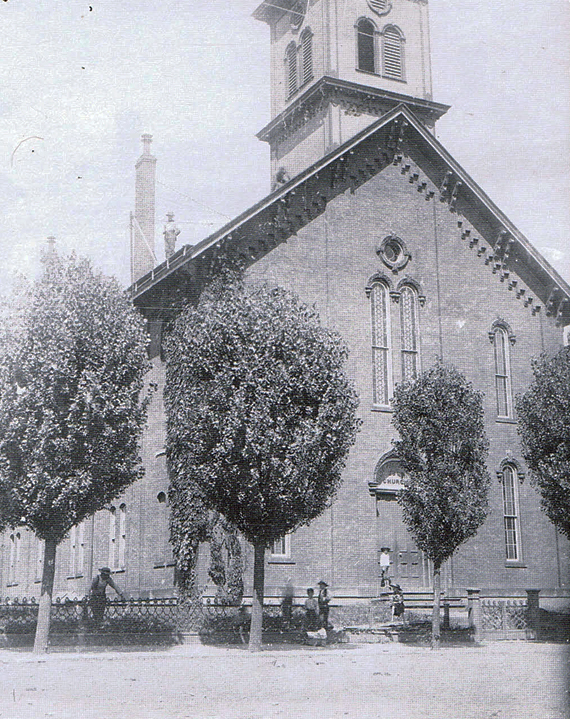
The First Presbyterian church, built in 1869 on Fourth Street between Washington and Market Streets.
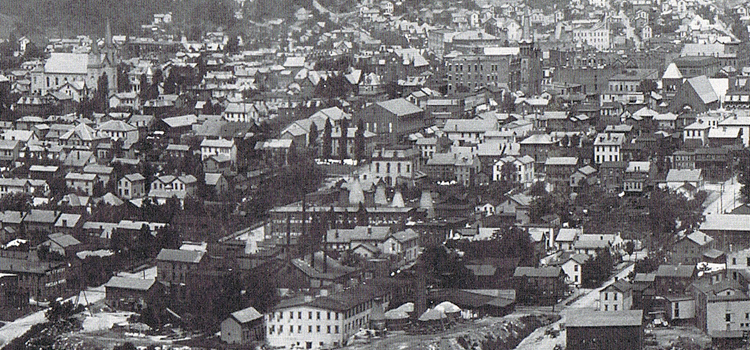
This particular photograph from 1898 shows on the far right a rebuilt First Presbyterian Church which was located at the corner of East 4th Street and Mulberry Alley.
From personal memories of Maxine Pardee:
By the way, there was always a certain amount of competition between the 2 Presbyterian denominations. When the Presbyterian church was built on 4th street, they made an attempt to make their steeple higher than the UNITED Presbyterian steeple on 6th. They wanted to be more visible to the riverboats. It lasted for a while, then collapsed from its own weight during a funeral. -- Pride goes before a fall! The denominations united in the 50's and are all that are still active part of the PC(USA.
The First Presbyterian Church of East Liverpool was organized on January 31, 1845 by sixteen members of the Long's Run Church. Long's Run had been organized in 1800 and was one of the oldest Presbyterian Churches in the state.
The new congregation elected three prominent Sons of Revolutionary War veterans as elders. Michael McKinnon and John Fisher were farmers whose farms bordered the city and their names are now familiar to us as streets and subdivisions. Sanford C. Hill was a surveyor and nationally known astronomer and publisher of almanacs.
The first house of worship was erected on the northwest corner of Third and Jackson Streets (this building was only recently razed).

First Presbyterian Church. Picture from the Museum of Ceramics.
For a period of twenty- two years the church was served by stated supply or part time ministers. In 1867 the congregation erected a new brick building on Fourth Street. In 1877 Rev. T.V. Milligan was called as pastor and his descendents still operate the Milligan hardware. He was followed by Rev. A.B. Marshall, who was called to be pastor in 1877. Shortly after the arrival of Rev. Marshall a large crowd at a funeral caused structural damage to the building, and although it was only twenty years old it was torn down and a new larger building erected on the same site. During the erection of the new building the congregation worshipped in the Old Jumbo Skating Rink. In 1894 Dr. John Lloyd Lee became pastor, and he was followed by Dr. E.M. McMillin in 1904. During this time the congregation founded chapels in west end, northside and east end. Two of these chapels eventually became Emmanuel and Grace Presbyterian Churches.
Rev. Donald William MacLeod was pastor from 1912 until 1927. He was followed by Dr. James Lawther, who remained until 1938. Rev. M. Rudolph Miller became pastor in 1940 and except for four years when he served as a chaplain in the U.S. Army he served as pastor until 1967. During the war the church was served by Rev. Arthur French, a missionary who had been forced to return to this country from China.
In 1958 the Presbyterian Church U.S.A. merged with the United Presbyterian Church of North America to form the United Presbyterian Church in the U.S.A. In 1959 the congregation voted to change its name to Trinity United Presbyterian Church.
In 1960 construction was begun on a new building on the northside. This new and different building was located on eight acres of land high over looking the Ohio River.
In 1961 Dr. H. Gene Toot came as Associate Pastor of Trinity and he remained as pastor when Rev. Miller resigned in 1967. In 1983 the United Presbyterian Church united with the Presbyterian Church U.S. (southern) and today the official name of the congregation is Trinity Presbyterian Church.
The above article first appeared in the Sesquicentennial 1934-1984 East Liverpool, Ohio Booklet.
The above Picture is from Dr. Birket's Magic Lantern Slides and is #93. It shows the rebuilt version of the church.

The current church.
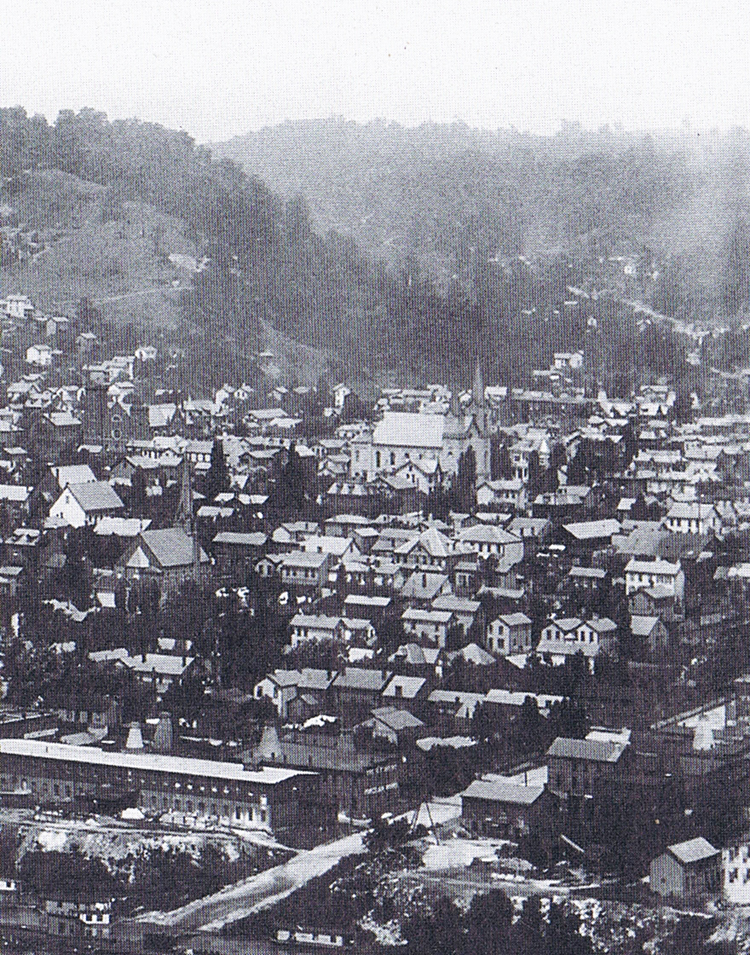
In this 1898 photograph of ELO we have one church we have already discussed shown, the Methodist Episcopal Tabernacle in the upper right of the photograph, plus the introduction of two new churches.
In the lower center of the photograph is the St. John's Evangelical Church and upper left of the photograph is the second Catholic Church.
ST. JOHN'S EVANGELICAL LUTHERAN CHURCH
St. John's Lutheran Church was built on the Southeast corner of Third and Jackson Streets in 1896.
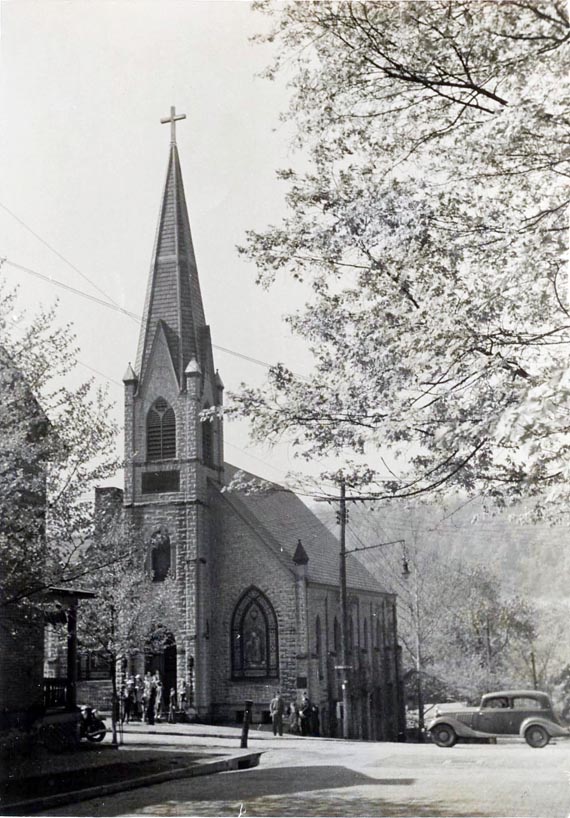
St. John's Evangelical Lutheran Church. From the Inger Lloyd collection.
History of Columbiana County, Ohio - Harold B. Barth Historical Publishing Company 1926,CHAPTER XVIII, CHURCHES, CONTINUED:
St. John's Evangelical Lutheran Church was the outgrowth of this denomination and the Reformed Protestant Church whose members enjoyed occasional worship in East Liverpool as early as 1854. They employed ministers in common and held services in dwellings and school houses. The Rev. Mr. Lenakemper served them until 1858. For several years thereafter no meetings were held. In 1864 Rev. Henry Reit revived interest in the adherents of the denomination. He served them until 1868 and was succeeded by Rev. Mr. Geiser.
During the pastorate of Rev. Mr. Geiser the two organizations joined in the erection of a brick edifice on Third Street. It became known as The German Lutheran Church. This was replaced in 1896 by a brick and stone structure costing $25,000. Dr. J. G. Reinartz was then the pastor. It was dedicated on Nov. 29, 1896.
Succeeding Rev. M. Geiser were the following pastors: Revs. Mr. Steinbach, John Fritsch, George Becker, Mr. Born, M. Kreugler and John Fritsch for the second time. Rev. Mr. Fritsch also served at the same time a church at New Castle, Pa. The membership of the church was then but 15.
With a membership of 24 Dr. J. G. Reinartz, the present pastor, began his long pastorate on June 6, 1886. The church began and has continued to grow under his supervision. There were 500 enrolled members in 1905. The church celebrated the twenty-fifth anniversary of Dr. Reinhartz's ministry on Dec. 3, 1911, with sermons by Rev. C. Theophilus Bentz, president Thiel College, Greenville, Pa., who spoke in German and Rev. J. L. Smith, D. D., Pittsburg, Pa. In 1923 the church was overhauled and repaired. The brick walls were coated with cement, giving the whole the appearance of a stone edifice. A commodious Sunday School room has been arranged on the basement floor with a Jackson Street entrance. The cost of the improvements was $10,000. The present membership is 600 baptized persons. During his pastorate Dr. Reinhartz has buried 475 members of his church.
In the rear of the church on Jackson Street a commodious parsonage has been built. With an additional lot next to the church on Third Street the property owned by the congregation is valued at about $100,000.
In the early 1970's the Third Street Saint John Lutheran Church was demolished for Route 11 construction. The new Saint John Lutheran Church was built in 1973 in a fringe residential neighborhood and outside the city limits.
Church Mysteries and Changes 4
This site is the property of the East Liverpool Historical Society.
Regular linking, i.e. providing the URL of the East Liverpool Historical Society web site for viewers to click on and be taken to the East Liverpool Historical Society entry portal or to any specific article on the website is legally permitted.
Hyperlinking, or as it is also called framing, without permission is not permitted.
Legally speaking framing is still in a murky area of the law
though there have been court cases in which framing has been seen as violation of copyright law. Many cases that were taken to court ended up settling out-of-court with the one doing the framing agreeing to cease framing and to just use a regular link to the other site.
The East Liverpool Historical Society pays fees to keep their site online. A person framing the Society site is effectively presenting the entire East Liverpool Historical Society web site as his own site and doing it at no cost to himself, i.e. stealing the site.
The East Liverpool Historical Society reserves the right to charge such an individual a fee for the use of the Society’s material.